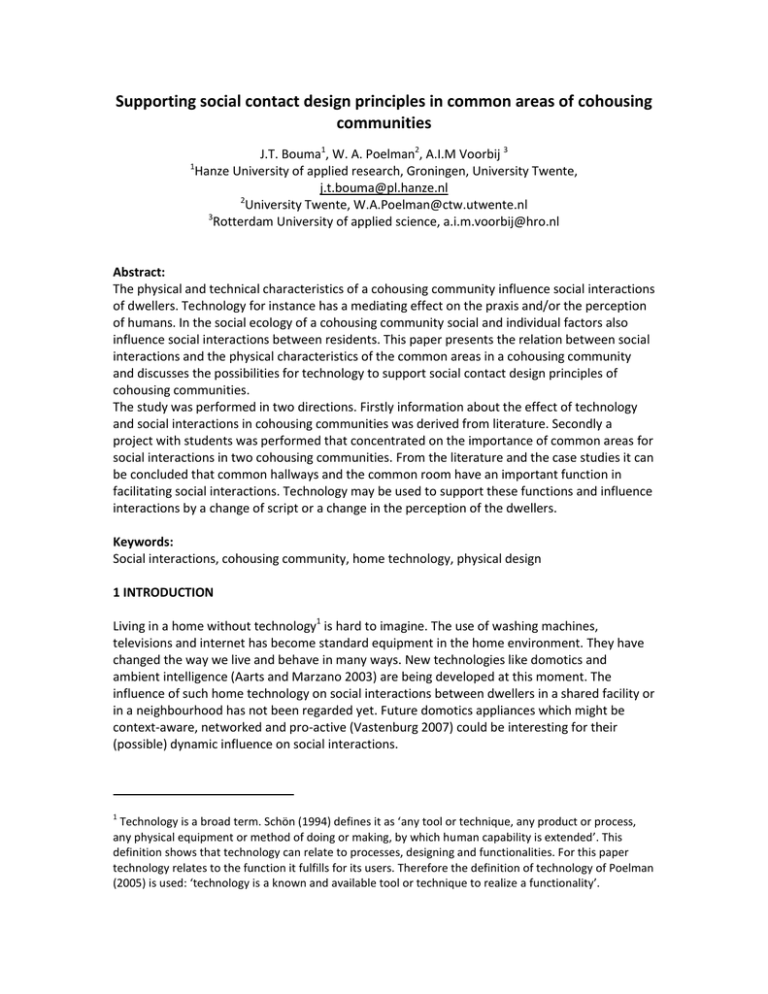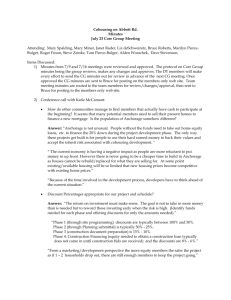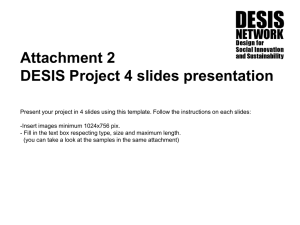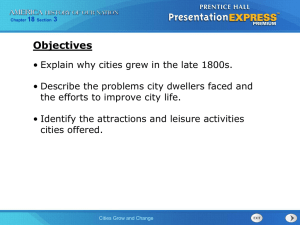Creating possibilities for social interaction in common areas of a
advertisement

Supporting social contact design principles in common areas of cohousing communities J.T. Bouma1, W. A. Poelman2, A.I.M Voorbij 3 Hanze University of applied research, Groningen, University Twente, j.t.bouma@pl.hanze.nl 2 University Twente, W.A.Poelman@ctw.utwente.nl 3 Rotterdam University of applied science, a.i.m.voorbij@hro.nl 1 Abstract: The physical and technical characteristics of a cohousing community influence social interactions of dwellers. Technology for instance has a mediating effect on the praxis and/or the perception of humans. In the social ecology of a cohousing community social and individual factors also influence social interactions between residents. This paper presents the relation between social interactions and the physical characteristics of the common areas in a cohousing community and discusses the possibilities for technology to support social contact design principles of cohousing communities. The study was performed in two directions. Firstly information about the effect of technology and social interactions in cohousing communities was derived from literature. Secondly a project with students was performed that concentrated on the importance of common areas for social interactions in two cohousing communities. From the literature and the case studies it can be concluded that common hallways and the common room have an important function in facilitating social interactions. Technology may be used to support these functions and influence interactions by a change of script or a change in the perception of the dwellers. Keywords: Social interactions, cohousing community, home technology, physical design 1 INTRODUCTION Living in a home without technology1 is hard to imagine. The use of washing machines, televisions and internet has become standard equipment in the home environment. They have changed the way we live and behave in many ways. New technologies like domotics and ambient intelligence (Aarts and Marzano 2003) are being developed at this moment. The influence of such home technology on social interactions between dwellers in a shared facility or in a neighbourhood has not been regarded yet. Future domotics appliances which might be context-aware, networked and pro-active (Vastenburg 2007) could be interesting for their (possible) dynamic influence on social interactions. 1 Technology is a broad term. Schön (1994) defines it as ‘any tool or technique, any product or process, any physical equipment or method of doing or making, by which human capability is extended’. This definition shows that technology can relate to processes, designing and functionalities. For this paper technology relates to the function it fulfills for its users. Therefore the definition of technology of Poelman (2005) is used: ‘technology is a known and available tool or technique to realize a functionality’. The older people get, the more time they spent in the home environment (Drooglever Fortuin et al. 2006). So the neighbourhood increases in importance as a place to keep the social network at an acceptable level. This reveals the importance to have an optimal environment for social interactions. An example of a facility that has been designed to provide an optimal environment for social interactions between dwellers is a cohousing community. Such a facility is a community that has been set up by the dwellers themselves, where people can live independently and at the same time can have optimal social interactions. A cohousing community consists of individual apartments and common areas like activity rooms, shared (bike) storage and gardens. From a first research it has been found that technology like safety systems have already been adopted in many cohousing communities. Changes in the script of the community through these technologies have led to expected and unexpected changes in social interactions. The influence of technology will depend on several factors; social and individual factors influence the behaviour of dwellers as well (Bouma and Voorbij 2009). New technology should therefore be able to fit in the social system of a cohousing community. 1.1 The effect of technology The effect of technology on humans can be analyzed from a functional point of view. A product can be a solution for a certain need of a user of the product. If the product fulfils the goal of the user in an efficient, effective and desirable way the product scores high on usability (ISO 1998). But this approach doesn’t clarify the total effect of the product on the life of the users. A car did have a much bigger effect on users than driving people from A to B in a faster and more efficient way. People were able to live in a place far from their work. Go to other places doing things they couldn’t do before. In general the innovations in transport and communication did have a major influence on norms and values and aspects of social peer control of people (van Lente 1988). According Verbeek (2006) technology has a mediating role between humans and reality: ’Technologies enable us to perform actions and have experiences that were scarcely possible before, thereby helping to shape how we act and experience things.’ Technology, therefore, is active: it helps to create a situation that was not possible without technology. Two perspectives of mediation can be discerned: one that focuses on perception and another one on praxis. The mediation of action (praxis) is related to the script concept. In this view technology is part of a script. A script is a framework defined by technical objects of action together with the actors and the space they are supposed to act (Akrich 1992). According Latour (1992) activities of humans are coshaped by the things they use. The script of artifacts suggests specific actions while inhibiting others (Verbeek 2006). A magnetron has the function to warm food in an easy way with preserving the quality of the food. This inhibits individual members of families to eat at a moment that suits them. In many families this had led to complete changed eating patterns. The mediation of perception has to do with amplification and reduction of certain aspects of reality (Verbeek 2006). Through the social network site Facebook people get to know aspects of friends which they wouldn’t know in face to face situations. What kind of music someone likes, which friends he/she has, etc. These aspects amplify the image of such a friend. But the use of Facebook also reduces aspects of reality. There is no face to face contact and communication is limited to chatting. The question is in which situations in a cohousing community new technology can have an influence on the behavior of dwellers. Cohousing communities have been designed according social contact design principles to have an optimal environment for social interactions. It would be interesting to see if the mediating effect of technology could be used for support of this social contact design. For this the context of a cohousing community needs to be considered. 1.2 The context of a cohousing community A cohousing community can be described as a social ecological system. It’s a dynamic interaction of individuals with their environment across time and space (Lounsbury and Mitchell 2009). In a cohousing community people have the possibility to share daily life activities in a specially developed facility. These facilities comprise of multiple dwellings (20-30) that are oriented around a common open area and a common building (Durret 2005). In such a community there is no condition of management. People are all equally responsible for the organization of the community. This dynamic interaction of individuals and their environment is an important aspect in cohousing literature. Social interactions are seen as an important aspect of cohousing and can be positively influenced by the physical design. This influence is enhanced by the presence of three variables. First variable is the opportunity for contact between residents, secondly the proximity of the apartments and thirdly the availability of appropriate space to interact (Fleming, Baum et al. 1985). The closer people are brought to each other, the greater the chance of meeting one another and the greater the chance of the formation of friendship and social interaction (Abu-Gazzeh 1999). Cohousing communities are generally designed with these variables in mind, the ‘social contact design principles’. Several studies in cohousing buildings show that these aspects like proximity of the dwellings, the position towards other houses, buffer zones between private and general space, position and quality of the common room, surveillance within the community and shared pathways indeed affect social interactions in the community (Fleming, Baum et al. 1985; Cooper Marcus 1986; Gehl 1987; McCammant 1994; Abu-Gazzeh 1999; Williams 2005). Communal spaces provide opportunities for social interaction. If a common room is situated centrally and accessible more dwellers will use the facility (Williams 2005). Furthermore common spaces (indoor and outdoor) need to be of good-quality and at the same time flexible (McCammant 1994; Abu-Gazzeh 1999). Opportunities for surveillance within the community are a key to higher levels of social interaction: “The nearby environment is the basis of communication and identification of common interests between inhabitants” (Abu-Gazzeh 1999) But even though cohousing communities have been designed according to these principles, it is not automatic that dwellers will have an active social life in such a community (Bouma and Voorbij 2009). It is therefore important to get more insight in those interactions. A first way of making contact in a community is through passive interactions with neighbors. Passive interactions are the unintentional encounter of persons (Abu-Gazzeh 1999). These interactions are a form of passive community building and may lead to feelings like ‘convenient’ social control, common feelings of security and/or wellbeing (Felbinger and Jonuschat 2006). If passive contacts between residents are frequent there is a probability of the formation of friendship and active social interactions (Abu-Gazzeh 1999). Active interactions are intentional and may lead to active community building like sharing interests between dwellers through common activities (Felbinger and Jonuschat 2006). These active interactions are a main characteristic of cohousing communities. Active interactions can be distinguished in informal and formal interactions. Informal interactions include the personal relationships between individuals (or relations within a group). Formal interactions relate to organizational policies and structures. In cohousing communities both forms of social interactions exist. In cohousing communities there is no condition of management. The design process and the daily organization are done by the dwellers of the community. Decision making is based on consensus between dweller. This means that dweller have to make decisions with each other on subjects that are important for the community. Most times formal meetings between dwellers are organized. Formal communication is not always easy. It may lead to conflicts between residents, which has been described in many communities (Brenton 1998; Meltzer 2005; Williams 2005). The possibility of conflicts is reinforced by differences in values and goals. The more people with interfering values and goals interact with each other, the more likely they have conflicts with each other. In order to prevent such conflicts cohousing communities try to attract a homogeneous group of people that have similar values and goals. This generally comes to people that choose to be actively involved in the community and are socially able. But it is not always possible to attract these people because sometimes residents find it difficult to select new dwellers or they have to choose new dwellers really quickly. That places a certain doubt upon the idea whether social interactions are a predictive measurement of social wellbeing. Social wellbeing is depending on the network of personal relationships and social exchanges that take place (Jong Gierveld 1998). When this network is included in a shared social network with forms of reciprocity and trustworthiness this can be seen as social capital (Portes 1998; Putnam 2007). Social interactions are a structural aspect of social capital. A cognitive aspect of social capital is related to trust and reciprocity of the social network. Aspects of trust and reciprocity may not be optimal in the case of conflicts within the community and should therefore be regarded for cohousing communities as well. It has been pointed out that physical design factors like common facilities have an influence on social interactions in a cohousing community. But the social contact design principles described in cohousing literature are limited to physical design factors while home technology has an influence on social interactions as well. Technology has a mediating effect on the praxis or the perception of the user. It might be interesting to integrate aspects of technology in the social contact design principles of cohousing communities. This paper therefore presents the relation between social interactions and the common areas in a cohousing community and discusses the possibilities for home technology to mediate that relation in a positive way. 1.3 Methods The study was performed in two phases. Firstly information about the effect of technology and social interactions in cohousing communities was derived from literature. Secondly a project with students was performed that concentrated on the importance of common rooms for social interactions in two cohousing communities. The students attended shared activities in both communities and collected data on their daily social interactions through activity diaries and structured interviews from 10 residents in community A and 7 residents in community B and collected photographs and information about the plan of the communities. The residents were asked and explained during an organized activity to participate in this research. For the question on the actual social interactions between dwellers in the community a classification of the Verwey Jonker institute has been used (van der Graaf, Boonstra et al., 2006). The communities differ in size and starting dates: community A has 21 apartments and started 22 years ago; community B has 14 apartments and started 14 years ago. Both communities are situated in an old multi-floor building that has been redesigned for the purpose of a cohousing community. This research is a follow up study of a first research on the social and physical aspects of cohousing in five cohousing communities. The result of this study has been reported in two papers (Bouma and Voorbij 2009; Bouma et al. 2009) 2 RESULTS From the analysis of the plan of the communities it is revealed that both communities have two major common areas in the building. These are the common hallway and the common room. The dwellers confirm the importance of these common areas for social interactions. According them the most important way to make contacts with other dwellers are the shared activities in the common rooms (n = 12), walking in the hallway (n = 10) or waiting for the elevator (n=7 in community A). Therefore the focus of the analysis lies on those areas of the communities. While the common room is used for active (sometimes formal) interactions, the interactions in the hallway and in front of the elevator are passive interactions like greetings and chats. Community A The common room in community A is located on the ground floor of the facility in the centre of the apartments (see figure 1). Although the common room is not located at the entrance most dwellers have to walk by the room to go to their apartments. Also the lift and stairs are situated near the common room. Several activities are organized in the common room: shared coffee drinking occurs twice a week, painting and shuffleboard once a week, twice a month a so called ’soos’ (having a drink together) and a cultural activity (e.g. a reading or theatre) with a shared meal once a month. Figure 1 The location of the common room in community A towards the private rooms and the entrance (ground floor). The shared hallways are important for passive social interactions (see figure 1). Greetings (n=6) and informal chats (n= 7) are the most called actual interactions in this community. The hallways can be considered a shared pathway in the community. Based on the plan it is expected that apartments in the immediacy of the common room and the entrance face a lot of passing. Besides the passive interactions in the hallways also active interactions between individual dwellers have been notified. Four people mention to have regular contact with other dwellers, three dwellers mention to go shopping for other dwellers, three share a holiday with other dwellers, four report to help each other in case of emergency and two invite other dwellers for social contact. They also noted in their diaries some non-regular common activities which were not linked to the common areas, like going to the market, visiting a zoo and going to a cultural event Community B The common room in community B is located in a separate part of the facility (see figure 2). Only the dwellers in the two apartments near the common room have surveillance over what is happening in the common room. Other dwellers don’t pass the common room in their normal walking routes. In community B the common activities consist of shared coffee drinking once a week and a formal meeting once a month. Occasionally they have shared meals during holidays or shared trips to the theatre. Also in this community passive interactions are important. Greetings (n= 4) and informal chats (n= 5) are the most called actual interactions in this community. The hallways in the community are divided in two different halls: a semi private hall and a shared hall (see figure 2). The semi private hall looks more like a hall in normal houses. It is a space between three apartments. One dweller relates to this place as the private area of the three households where they look after their common plants. The shared pathway for all dwellers is the stairway and the hall linked to the stairs. Besides the contacts in the common room and the passive interactions in the hallways, active interactions between individuals are less frequent in this community. One dweller reports to go shopping for other dwellers, two help each other in case of emergencies and one dweller invites people for social contact. Figure 2. The location of the common room in community B towards the private rooms and the entrance (ground floor). Based on the results an overview of the relations between general interaction principles, social contact design principle and social interactions has been made. Functionalities can be derived from these relations (see table 1). General Interaction principles Frequency of interaction Trust Reciprocity Shared Values Social contact design principles Hallway: Shared pathways Buffer zones between private and general space Surveillance Frequency of contact Interactions Common room: Good quality Flexibility Central position Accessible, Surveillance Active, informal: Activities like playing cards, drinking coffee, painting etc Passive, informal: Greeting and talking in the hallways Contact for small tasks (plants, shopping) Possible functionalities of technology Mediation of perception: Learning other aspects of dwellers for more contact Creating feelings of trust Mediation of action: Increase possibility to meet Mediation of action: Enhance visibility of common room Support in organizing: Reservation of rooms; visibility of attendees, etc Mediation of action and perception: Prevention of conflicts Support of selection Support of design decisions Active, formal: Meetings Selection Design process Contact with housing association Table 1 The relation between general interaction principles, social contact design principles, social interactions and possible functionalities of technology. 3 DISCUSSION AND CONCLUSION This research is a follow up study of a first research on the social and physical aspects of cohousing in five cohousing communities. The communities of the first research are comparable with the communities in this research. They differ in frequency and diversity of shared activities. The respondents were voluntary asked to fill in an activity diary during an organized activity. The respondents may therefore not totally represent the whole community; the procedure for collecting respondents in both communities has been the same. The differences in frequency and diversity of organized activities between the two communities can have many reasons. Reflecting on the cohousing literature the position of the common room in community B is not helping to support social activities. The room is not located at a central position, there is no surveillance and no shared pathways to the communal room. Technology based on these functionalities may influence the script of the community and therefore have a mediating effect on the behavior of dwellers. In the common room technology could be helpful in supporting the visibility of the common room. A possibility is to show people at the entrance if the common room is in use by someone or to notify dwellers in their apartment about activities in the common room. Especially for dwellers with physical limitations this might be an interesting option. Another possible function for technology might be to support dwellers in organizing activities in the community. If it is easy for dwellers to invite people for an activity, to make a reservation for a room and to see who will attend this activity, possible barriers for organizing such an event might be overcome. Formal activities occur in both communities and are seen as a base for conflicts in many cohousing communities. Social contact design principle may not have a big influence on these interactions, besides that a good quality of the common room invites people to use the room and helps to enable good edging conditions for meetings. Possible functions like support of selection of new dwellers and gaining consensus for design decisions may help in solving or preventing conflicts. An example of such a system would be a consensus support system for group decision-making (Herrera-Viedma, Martinez et al. 2005). Such a system could have an influence on the scripts of the actions but also on the perception of dwellers. In both communities passive interactions like greeting and chatting between residents are the most frequent called contacts. The hallways are an important area for these interactions. In the cohousing literature shared pathways have been observed, but the design and functions of shared hallways have not received great attention yet. In the Netherlands Humanitas has paid attention to shared hallways, like the use of conversation pieces and empathic design in elderly homes in the Netherlands (Becker 2003). It would be interesting to see if their approach is also working for cohousing communities. In community B the hallway is separated in two functions: a semi-private part for three apartments and a general hallway which is combined with a stair. Semi private buffer zones provide good opportunities for social interactions. They provide a gentle transition between public and private space (Abu-Gazzeh 1999). But in community B this combined space may also lead to clustering within the community. In such a small community this may actually create social divides that otherwise would not exist (Williams 2005). In the case of dwellers that share such a hallway and have differences in values and goals this may lead to ‘territorial disputes’ (Williams 2005). In community A the active interactions are more frequent and divers. This means that community B is relying more on passive interactions. The probability of moving from passive to active interactions in community B is inclined due to a less optimal physical design. Technology might be able to influence these interactions by visualizing more aspects of the dwellers. In general the use of internet (especially social media) stimulates the amount, intensity of social contacts, relations and networks both online and offline (Frissen 2004). A form of social media within the community might be a starter for dwellers to have passive interactions on another level. Maybe by influencing the frequency of contact the probability of passive interactions becoming active interactions would increase. Also it would be interesting to see if a virtual community within a physical community would be able to compensate limitations in design. As explained in the introduction social media can influence the perception of users. Feelings of trust may enhance when dwellers have more background information of their neighbors. Off course these possibilities are assumptions that have not been tested yet, but they look promising enough to continue further research. This new technology could be interesting for existing communities that are located in buildings with limitations in their design or for buildings that are re-designed for a cohousing community. From the literature and the case studies the following conclusion can be drawn: Common hallways are important for passive interactions in a cohousing community. Common areas like hallways and the common room in a cohousing community have an important function in facilitating social interactions. Technology may have a role in facilitating these interactions by a change in actions or in the perception of the dwellers. In order to be able to conclude that these technologies have the desired influence on social interactions in cohousing communities more research is needed. The described functionalities in table 1 are far from complete and should be extended. The possible functionalities need to be associated with potential technologies (Poelman 2005) and developed into concepts that can be tested on their effectiveness. 4 ACKNOWLEDGEMENTS We would like to thank the dwellers of the cohousing communities for their support in conducting this research. We would also like to thank the students who helped to conduct the research especially Dafne van den Berg and Steven Michel from the ‘Atelier Wonen, Welzijn en Zorg’ of the Hanze University of Applied Research in Groningen. 5 REFERENCES Aarts, E. H. L. and S. Marzano (2003). The New Everyday: Views on Ambient Intelligence, 010 Publishers. Abu-Gazzeh, T. (1999). "Housing layout, social interaction and the place of contact in Abu-nuseir, Jordan." Journal of Environmental Psychology 19(1): 59. Akrich, M. (1992). The De-Scription of Technical Objects' in Bijker, W. & Law, J.(eds) Shaping Technology\ Building Society, Cambridge, Massachusetts: MIT Press. Becker, H. M. (2003). Levenskunst op leeftijd: geluk bevorderende zorg in een vergrijzende wereld, Eburon. Bouma, J. T. and A. I. M. Voorbij (2009). Factors in social interaction in cohousing communities. Include London. Bouma, J. T., A. I. M. Voorbij and W.A. Poelman, (2009). "The influence of changes in the physical and technical design on social interactions in a cohousing community." Lifecycle Design of Buildings, Systems and Materials: 100. Brenton, M. (1998). We’re in charge: CoHousing Communities of older people in the Netherlands: lessons for Britain? Bristol, Policy Press. Cooper Marcus, C. a. S., W (1986). Housing as if People Mattered: Site Design for Medium Density Family Housing. Berkeley, CA, University of California Press. Drooglever Fortuijn, J., van der Meer, M, Burholt, V, Ferring, D, Quatrrini, S, Rahm and I. Hallberg, Weber, G and Wenge, G,C (2006). "From Activity Patterns of Older Adults." Population, Space and Place 12: 353-369. Durret, C. (2005). Senior Cohousing: A Community Approach to Independent Living. Berkely, Habitat Press. Felbinger, D. and H. Jonuschat (2006). Promoting neighbourly interactions by the common use of green spaces, ENHR. Fleming, R., A. Baum, et al. (1985). Social support and the physical environment. Social support and health. S. Cohen and S. L. Syme: 327-345. Frissen, V. (2004). De domesticatie van de digitale wereld, Erasmus Universteit. Gehl, J. (1987). Life between Buildings: Using Public Space. New York, Van Nostrand Reinhold. Graaf, P., van der, N. Boonstra and Bos, I. R., (2006). Buurtcontact in Leiden Zuidwest, Verwey Jonker Institute. Herrera-Viedma, E., L. Martinez, Mata, F., Chiclana, F. (2005). "A consensus support system model for group decision-making problems with multigranular linguistic preference relations." IEEE Transactions on Fuzzy Systems 13(5): 644-658. ISO (1998). Ergonomics Requerements for Office Work with Visual Display Terminals (VDT's) ISO924-11. I. O. f. Standardization. Jong Gierveld, J, de (1998). "A review of loneliness: concepts and definitions, determinants and consequences." Reviews in Clinical Gerontology 8: 7. Latour, B. (1992). "Where are the missing masses? The sociology of a few mundane artifacts." Shaping technology/building society: Studies in sociotechnical change: 225-258. Lente, D. van, (1988). Techniek & ideologie: opvattingen over de maatschappelijke betekenis van technische vernieuwingen in Nederland, 1850-1920, Wolters-Noordhoff. Lounsbury, D. W. and S. G. Mitchell (2009). "Introduction to Special Issue on Social Ecological Approaches to Community Health Research and Action." American Journal of Community Psychology: 1-8. McCammant, K. and Durret, C (1994). Cohousing: A Contemporary Approach to Housing Ourselves. CA, Ten Speed Press. Meltzer, G. (2005). Sustainable Community, Learning from the Cohousing Model. Trafford, Victoria Canada. Poelman, W. A. (2005). Technology diffusion in product design, PhD thesis. Delft University of Technology, Delft, The Netherlands. Portes, A. (1998). "Social Capital: Its Origin and Applications in Modern Sociology." Annual Review Sociology 24: 24. Putnam, R., D (2007). "E Pluribus Unum: Diversity and Community in the Twenty-first Century, The 2006 Johan Skytte Prize Lecture." Scandinavian Political Studies 30(2): 35. Schön, D. A. and M. Rein (1994). Frame reflection: Toward the resolution of intractable policy controversies, Basic Books, New York. Vastenburg, M. H. (2007). Please do not disturb: modeling user experiences for considerate home products. Industrial Design. Delft, Technical University Delft. Ph.D. Verbeek, P. P. (2006). "Materializing Morality: design ethics and technological mediation." Science, Technology & Human Values 31(3): 361. Williams, J. (2005). "Designing Neighbourhoods for Social Interaction: The Case of Cohousing." Journal of Urban Design 10(2): 195-227.





